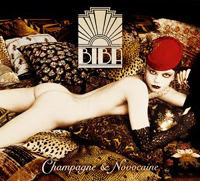My big Sister flew the nest in the mid seventies and headed to London to seek adventure, she left me, her seven year old little sister behind, she returned home often and started telling me wondrous stories about an emporium called BIBA, to me it sounded like Aladdins Cave, full of exotic and beautiful treasures, she often came home bearing gifts from this hallowed place, strings of beads, feather boas, patterned scarves and beautifully packaged eye shadows and lipsticks, all which went lovingly into my dressing up box.
Sadly by the time I flew the nest and headed down to London, BIBA was no longer but thanks to my Sister I have had a lifelong fascination for all things BIBA and it's creator Barbara Hulanicki.
Born in Warsaw in 1936, to Polish parents, after studying at Brighton School of Art, now the University of Brighton Faculty of Arts, Hulanicki won a London Evening Standard competition for beachwear in 1955. She began her career in fashion as a freelance fashion illustrator, working for various magazines, including Vogue, Tatler and Women's Wear Daily.
Hulanicki sold her first designs through a small mail-order business, featured in the fashion columns of newspapers such as the Daily Mirror. In 1964 she opened her Biba shop in Kensington, with the help of her late husband, Stephen Fitz-Simon.
The shop soon became famous for its stylishly decadent atmosphere and lavish decor inspired by Art Nouveau and Art Deco. It became a hangout for artists film stars and rock musicians, including Mick Jagger and the Rolling Stones, David Bowie, Marianne Faithfull and Cathy McGowan, presenter of Ready Steady Go!, among the regulars. In the shop affordable mini-skirts, floppy felt hats, feather boas, velvet trouser suits and unisex T-shirts dyed in rich, muted colors were eagerly snapped up by a young clientele. Anna Wintour got her start in fashion as a BIBA employee.
The avant-garde BIBA cosmetic brand was being sold in 33 countries across the globe.
BIBA finally closed it's doors in 1976, a victim of corporate raiding before the term had even entered the business vernacular. But the scene was set, BIBA was the blueprint for a new style of fashion store, shops like Bus Stop and Top Shop started to spring up following the BIBA example.
The BIBA look has now become iconic and a firm favourite for stylists and glossy magazines.
To find out more about Barbara Hulanicki and her latest projects visit her at:
http://www.barbarahulanickidesign.com/main.htm
Text Sources from Wikipedia and barbarahulanickidesign.com
The First BIBA store was an Old Chemist shop in Abingdon Road, but by the time it closed it doors in 1976 it had evolved into an elaborate 5-story, Art Deco department store with a restaurant and a roof garden, overlooking High Street Kensington.
The avant-garde BIBA cosmetic brand was being sold in 33 countries across the globe.
BIBA finally closed it's doors in 1976, a victim of corporate raiding before the term had even entered the business vernacular. But the scene was set, BIBA was the blueprint for a new style of fashion store, shops like Bus Stop and Top Shop started to spring up following the BIBA example.
The BIBA look has now become iconic and a firm favourite for stylists and glossy magazines.
Twiggy
Kate Moss
Gloria Swanson Edward Steichen
The inspiration for the BIBA look came from the Twenties and Thirties, these two Steichen photographs look as if they could have been part of a BIBA campaign.
Marion Morehouse and Helen Lyons, Edward Steichen
After the closure of Biba, Hulanicki continued to work in the fashion industry, designing for such fashion designers as Fiorucci and Cacharel and for twelve years, from 1980 to 1992, designed a successful line of children's wear, Minirock, licensed to the Japanese market.
From 1990 to 2006, Hulanicki has perhaps had the most impact on Miami Beach through her work for Chris Blackwell and his Island Outpost Group. She twice reconceived the MARLIN Hotel, on Collins Avenue, as well as the CAVALIER Hotel, Ocean Drive, the LESLIE Hotel, Ocean drive, The NETHERLANDS building, Ocean Drive, and the KENT on Collins Avenue. Other Caribbean properties she has designed for Blackwell include the COMPASS POINT Hotel and beach resort in Nassau, Bahamas - which is prominently featured in all the Bahamian Tourist Board television commercials - the PINK SANDS resort on Harbor Island, Bahamas. In 1993 Hulanicki won an award from the American Institute of Architects for her work on the NETHERLANDS, as well as an award from an association of Florida Architects. Hulanicki's other projects have included private luxury homes on Palm Island and Dilido Island in Miami as well as several commercial properties, including the BEACH HOUSES at CORAL SANDS HOTEL on Harbor Island, Bahamas and hotel development for Chris Blackwell's GOLDENEYE in Oracabessa, Jamaica
One of the crowning achievements of Hulanicki's impact can be witnessed in the opening of the Hollywood hit movie "The Birdcage". A sweeping helicopter shot flows over the waves to zero in on the primary location for the film, the Cleveland Hotel on Ocean Drive, which is flanked by no less than four Hulanicki-designed buildings - the Leslie, the Cardozo, the Cavalier and the Netherlands. Additionally, throughout her career, Hulanicki has designed costumes for several stage and film productions, including clothing for Cathy McGowan on the influential live TV rock show "READY STEADY GO" (1964), outfits for Julie Christie in "DARLING" (1965), costumes for local productions in Miami Beach, costumes for old friend and Biba model Twiggy for "CAPTAIN BEAKY" in London's West End and her Royal Command Performance in 1976. From 2001 to 2002 she worked on the Island life Ministore, located in the heart of Miami Beach on Ocean Drive. Hulanicki renovated this unique shop at owner Chris Blackwell's request. Coined as "tropical lux," this lifestyle store contained a large collection of ethnic gift items, music, film, jewelry and accessories from around the world. It also boasted men's, women's and children's apparel custom designed by Hulanicki.
In 2003 she delved back into product and fashion design, with a collection of handbags for Coccinelle, Italy, Wallpapers and Illustrations for Graham and Brown, both of which still retain her to design new collections. She has also designed Wallpaper and textile designs for HABITAT stores in the UK. In 2008 she went back to her roots and designed a fashion collection for TOP SHOP, which included her fashion illustrations used as prints. The Victoria and Albert Museum recently republished her memoirs FROM A TO BIBA and accompanied the book launch with a range of her jewelry and scarf designs. Subsequently her autobiography inspired November Films, an Independent Film Company, to document her life and career in a recently released feature film called BEYOND BIBA.
To find out more about Barbara Hulanicki and her latest projects visit her at:
http://www.barbarahulanickidesign.com/main.htm
Richard Saker
I was very distressed to find the film documentary 'Beyond Biba' was broadcast on the British Sky Arts Channel on August 17th, can't believe I missed it, that will teach me to remember to look at the TV listings! the book and DVD are going on my wishlist!




















































